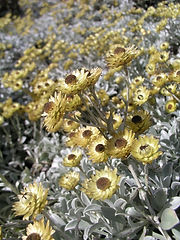
WHANGĀREI QUARRY GARDENS



The Gardens are home to an amazing array of native and exotic subtropical plants. Here are some of our favourites....
Ficus auriculata
syn. Ficus roxburghii
Common name: Elephants ear fig, Roxburghs fig, or giant red fig.
Fun facts: Native to India, these trees produce flowers and fruit from their woody trunks rather than from new growth and shoots. This allows trees to be pollinated or have their seeds dispersed by animals which cannot climb or fly.



Capsicum pubescens 'Manzano'
Common name: Manzano chili
Fun facts: Found naturally in the Andes, it is tolerant of cool temperatures and high altitudes. The flesh becomes yellow-orange as it ripens, and contains unusual
black seeds. BEWARE these chilis are extremely hot, with a rating of up to 30,000 units on the Scoville heat index.


Puya venusta
Common name: N/A
Fun facts: Puya venusta is a rather rare form of Bromeliad that is native to Chile. The foliage is a striking silver-grey and has dangerously sharp spines running along the length of each leaf. If you are lucky enough to see it flower (Spring) you will be amazed by the vivid colour of their blue blooms, a very unusual colour in nature!


Ficus dammaropsis
Common name: Kapiak, dinner-plate fig, highland breadfruit.
Fun facts: Our most talked-about plant at the Gardens! The round 'fruit' which can be seen year-round in Northland is in fact a special type of flower called a 'syconium'. These amazing trees need a specific wasp to pollinate them however, so we never see their mature fruit in NZ.



Allamanda cathartica
Common name: Golden trumpet vine.
Fun facts: Grown as a climber or a shrub, Allamanda cathartica is widely cultivated in its native tropical America. During our summer, it puts on an eye-catching and highly fragrant show for visitors. Be warned however, you can look but DON'T touch, these flowers are known to be poisonous to humans!



Ceiba speciosa
Common name: Silk floss tree
Fun facts: The silk floss tree is native to the tropical and subtropical forests of South America. Aside from a remarkable flower and an amazing spiky trunk, the fruit pods of this tre contain a cotton-like fibre that has many traditional uses including rope-making, canoe-building, and the production of paper pulp.


Backhousia citriodora
Common name: Lemon myrtle.
Fun facts: For centuries Aboriginal people used the leaves of this highly fragrant Australian native shrub in cooking and medicine; the sweet lemon flavour and powerful antiviral properties making it a sought-after herb. Today, it is grown commercially for these same properties. It also makes a fine garden specimen!



Macrozamia communis
Common name: Burrawang.
Fun facts: This cycad is endemic to coastal NSW and belongs to an ancient division of the plant kingdom that has changed little since the Jurassic period (dinosaurs ate them!). In its natural environment, the bright red to yellow seed cones are formed after fire, with male and female cones appearing on separate plants.


Ananas bracteatus
Common name: Red pineapple.
Fun facts: Native to South America, this short-lived perennial is grown as a garden plant in subtropical climates throughout the world. The striking fruit is edible, though not as sweet and fleshy as the usual market-variety pineapple. Its strong, spiny leaves make it an excellent choice as a 'security hedge'; fruit-poachers beware!


Dichorisandra thyrsiflora
Common name: Blue ginger.
Fun facts: Due to it's growth and habit, Dichorisandra thyrsiflora is commonly known as 'blue ginger', though it is in fact related to the spiderworts. This tropical herb is abundant in the Atlantic forests of Brazil, its native habitat. 'Blue ginger' loves warm, moist, and shady conditions, so is very much at home in some corners of the Gardens.



Elatostema rugosum
Common name: Parataniwha.
Fun facts: A native groundcover which only grows in the North Island, it can be found flourishing near streams and waterfalls at Whangarei Quarry Gardens. Its prominently veined leaves are toned from green to a striking red or purple, and are reminiscent of some of the exotic ornamental begonias, though there is no botanical relationship.


Iresine herbstii
Common name: Blood-leaf.
Fun facts: Originally from Brazil, Iresine herbstii is a vigourous garden plant if given the right conditions. It is classified in the Aramanthus family which contains several culinary and ornamental garden plants. The red-purple leaves of Iresine add a truly striking splash of colour, and divide opinions of many visiting gardeners...


Helichrysum argyrophyllum
Common name: Golden guinea everlasting, or 'vaalsewejaartjie'.
Fun facts: This South African groundcover thrives in full sun and low-nutrient, free-draining soils. The distinctive silver foliage catches the eye from a great distance, while the bright yellow blossoms make excellent cut-flowers, hence the common name 'everlasting'.


Aloe arborescens
Common name: Tree aloe.
Fun facts: This succulent tree blossoms in winter, sending up vivid red-orange spikes of nectar-filled flowers that provide winter food for nectar loving birds and insects. Aloe arborescens (meaning 'tree-like') is closely related to the wonderful Aloe vera, and is currently being studied for its own reputed medicinal properties

